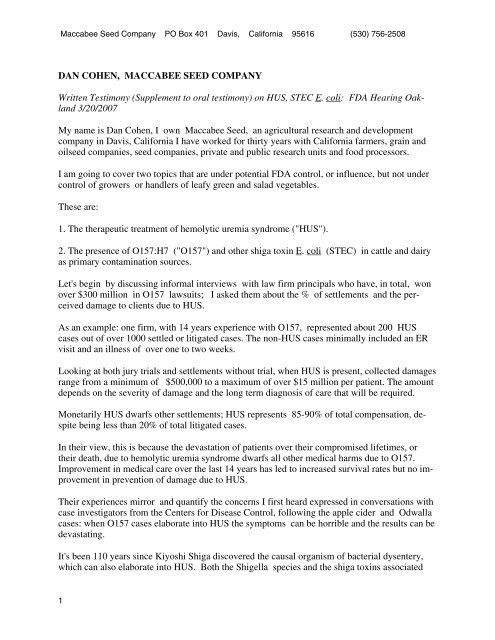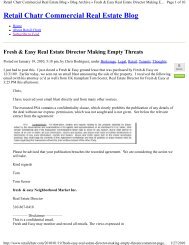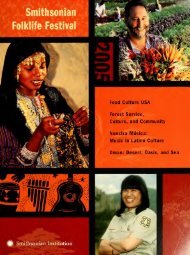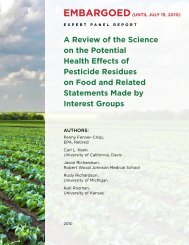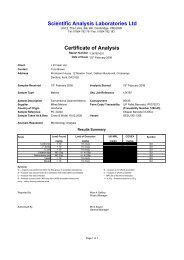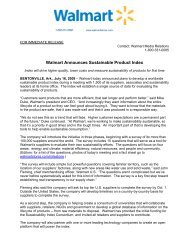Written Testimony - Perishable Pundit
Written Testimony - Perishable Pundit
Written Testimony - Perishable Pundit
Create successful ePaper yourself
Turn your PDF publications into a flip-book with our unique Google optimized e-Paper software.
Maccabee Seed Company PO Box 401 Davis, California 95616 (530) 756-2508<br />
DAN COHEN, MACCABEE SEED COMPANY<br />
<strong>Written</strong> <strong>Testimony</strong> (Supplement to oral testimony) on HUS, STEC E. coli: FDA Hearing Oakland<br />
3/20/2007<br />
My name is Dan Cohen, I own Maccabee Seed, an agricultural research and development<br />
company in Davis, California I have worked for thirty years with California farmers, grain and<br />
oilseed companies, seed companies, private and public research units and food processors.<br />
I am going to cover two topics that are under potential FDA control, or influence, but not under<br />
control of growers or handlers of leafy green and salad vegetables.<br />
These are:<br />
1. The therapeutic treatment of hemolytic uremia syndrome ("HUS").<br />
2. The presence of O157:H7 ("O157") and other shiga toxin E. coli (STEC) in cattle and dairy<br />
as primary contamination sources.<br />
Let's begin by discussing informal interviews with law firm principals who have, in total, won<br />
over $300 million in O157 lawsuits; I asked them about the % of settlements and the perceived<br />
damage to clients due to HUS.<br />
As an example: one firm, with 14 years experience with O157, represented about 200 HUS<br />
cases out of over 1000 settled or litigated cases. The non-HUS cases minimally included an ER<br />
visit and an illness of over one to two weeks.<br />
Looking at both jury trials and settlements without trial, when HUS is present, collected damages<br />
range from a minimum of $500,000 to a maximum of over $15 million per patient. The amount<br />
depends on the severity of damage and the long term diagnosis of care that will be required.<br />
Monetarily HUS dwarfs other settlements; HUS represents 85-90% of total compensation, despite<br />
being less than 20% of total litigated cases.<br />
In their view, this is because the devastation of patients over their compromised lifetimes, or<br />
their death, due to hemolytic uremia syndrome dwarfs all other medical harms due to O157.<br />
Improvement in medical care over the last 14 years has led to increased survival rates but no improvement<br />
in prevention of damage due to HUS.<br />
Their experiences mirror and quantify the concerns I first heard expressed in conversations with<br />
case investigators from the Centers for Disease Control, following the apple cider and Odwalla<br />
cases: when O157 cases elaborate into HUS the symptoms can be horrible and the results can be<br />
devastating.<br />
It's been 110 years since Kiyoshi Shiga discovered the causal organism of bacterial dysentery,<br />
which can also elaborate into HUS. Both the Shigella species and the shiga toxins associated<br />
1
Maccabee Seed Company PO Box 401 Davis, California 95616 (530) 756-2508<br />
with HUS are named after him. About thirty years ago the genes associated with shiga toxin laterally<br />
transferred to E. coli strains. Unlike dysentery, coliform bacteria were generally perceived<br />
as indicator species for fecal contamination and as early warning signals for far more serious<br />
diseases.<br />
With hindsight, the appearance of shiga toxin E. coli should have been treated from the beginning<br />
as a new disease entity; and as a model case for appearance of a toxin-associated, highly<br />
pathogenic disease, with many of the same characteristics public health officials would have to<br />
deal with in an intentional contamination.<br />
In my view, the FDA should lead an interagency working group covering all aspects of contamination<br />
and outbreaks including therapeutics. This should include special funding and research on<br />
HUS therapies.<br />
[The only therapeutic I know of entering phase II clinical trials is a (monoclonal antibody) mAb<br />
combination antitoxin; research originally done at the Uniformed Services University, sublicensed<br />
and now controlled by a biotech company in Canada; it has Orphan Drug status in the<br />
US and EU.]<br />
For the leafy green and salad industries, better therapeutics for HUS would mean that growers,<br />
handlers and consumers would be exposed to the risk of a greatly reduced harm.<br />
The FDA-led working group should also conduct a complete review of off-site health dangers<br />
posed by practices in the production of meat and milk in the<br />
cattle and dairy industries. Cattle and dairy have been repeatedly identified as the principal reservoir<br />
of O157 and other shiga toxin E. coli strains of concern. They have also been reported to<br />
be important origins and reservoirs of multiple antibiotic resistances of concern to human health.<br />
Both reservoirs should be identified and reduced.<br />
For the leafy green and salad industries, a reduction in the sources and reservoirs of contamination<br />
would mean a much smaller risk of causing a harm. They would have a safer environment in<br />
which to operate. An environment, for example, with uncontaminated irrigation water.<br />
Better therapeutics for HUS combined with reduction in the reservoirs and sources of contamination<br />
would result in a reduced risk of a greatly reduced harm. I think improvements in growing<br />
and handling practices will be more effective in a lower risk environment.<br />
Thank you for hearing my testimony.<br />
[Both of these risk reductions are scale neutral; they would benefit farm operations of all sizes<br />
from Hmong farmers with under 10 acres, to organic farmers with 2-300 acres, to the very large<br />
operations with tens of thousands of acres and multiple locations.<br />
Some proposed changes in food safety regulation are not scale neutral, and may adversely affect<br />
smaller farmers far more significantly.<br />
2
Maccabee Seed Company PO Box 401 Davis, California 95616 (530) 756-2508<br />
I was partly motivated to testify today by concerns expressed by NRCS (Natural Resource Conservation<br />
Service) and RCD (local Resource Conservation District) staff and local farmers. Their<br />
fear is that some of the food safety proposals attempt to create a sterile farm landscape ("farmscape"),<br />
which would undo decades of work on farms as environmental benefits. I have the<br />
same concerns.<br />
An approach to the food safety issue was developed by the Community Alliance with Family<br />
Farmers (CAFF) and summarized in testimony by Judith Redmond before the California Senate<br />
and Assembly Agriculture Committees, Joint Session, February 27, 2007. I agree with their conclusions,<br />
reached independently of my own work (available at www.caff.org).<br />
In my view, the outbreak record, and testimony at three California legislative hearings suggests<br />
the following priorities:<br />
1. First, review or clean-up the major operations in the processed leafy green and salad industry<br />
from planting through packaging. This includes ensuring standard food safety procedures for<br />
processing and packaging.<br />
2. Second, review or improve safety in the transportation of processed leafy greens and salads to<br />
the retail level; including records of temperature controls.<br />
3. Third, review or improve the safety of the actual packaging ("bags"), as an environment for<br />
potential microbial growth. This would include checking the adequacy of safety of sell-by or<br />
use-by dates.<br />
4. Fourth, review or clean-up operations in the Salinas valley, and other regions where there are<br />
found to be area-wide issues and concerns affecting most growers.<br />
5. Fifth, provide information, testing and cheap accurate testing equipment for smaller farm operations<br />
to use to enhance their food safety.<br />
There are great benefits to U.S. consumers from the convenience of prepared, packaged fresh<br />
vegetable from baby carrots to salad mixes. There are also great benefits from the fresh fruits and<br />
vegetables of local producers in farmers markets, coops and regional or specialized markets.<br />
Food safety regulations designed for large national producers may end up harming local producers,<br />
even when they are ineffective.]<br />
[Statements contained in brackets will not be presented in oral testimony]<br />
Dan Cohen<br />
Maccabee Seed Company<br />
PO Box 401 Davis, CA 95617<br />
(530) 756-2508<br />
3


